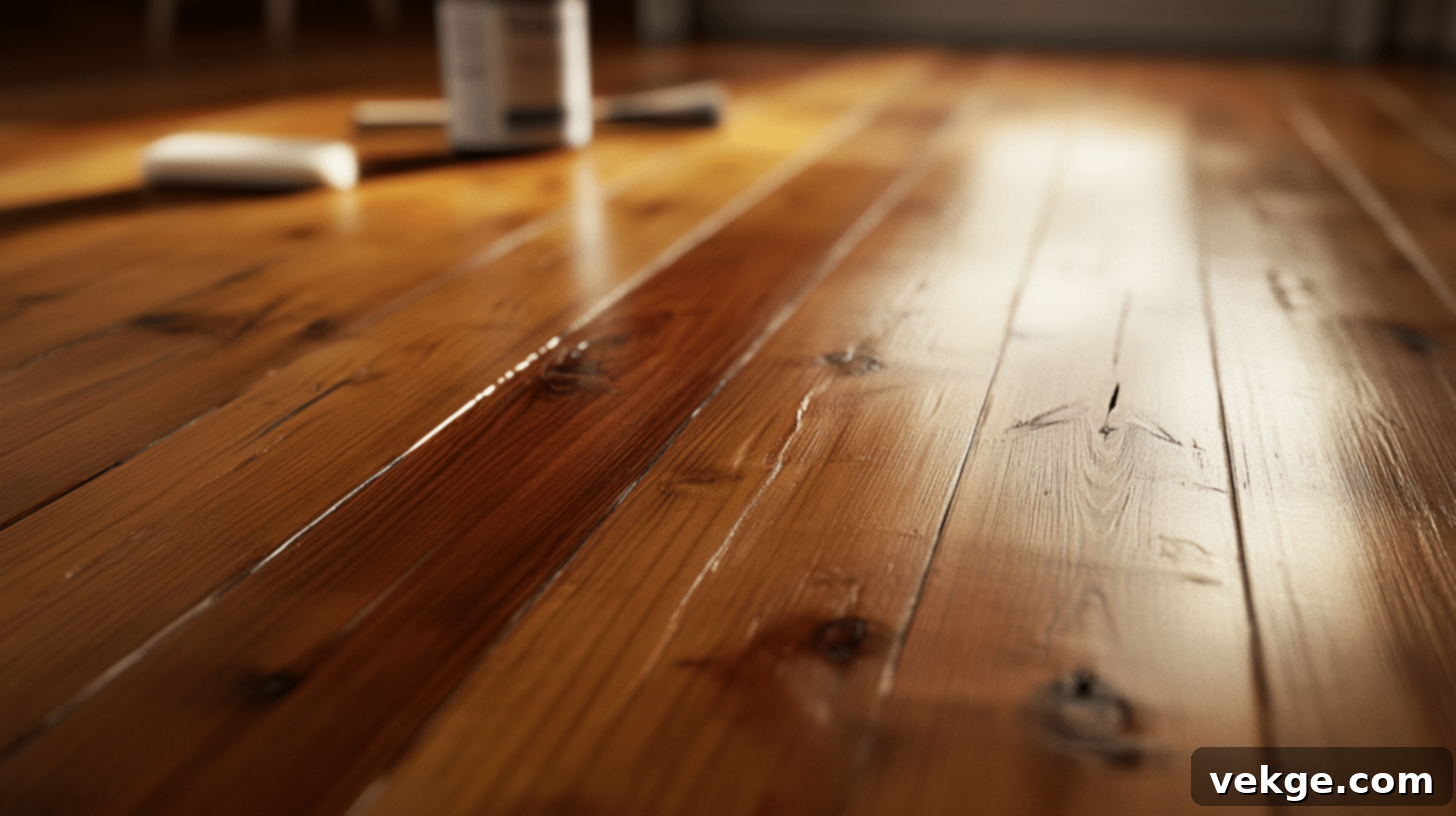Transform Your Pine Floors: A Comprehensive Guide to Finishes, From Hardwax Oil to Varnish
Choosing the right finish for your pine floors is a crucial decision that impacts not only their aesthetic appeal but also their durability, maintenance requirements, and overall lifespan. With a myriad of options available, understanding the unique characteristics of each can feel overwhelming. How do you ensure your choice aligns with your lifestyle, the traffic level of your space, and your desired look?
In this comprehensive pine floor finishes comparison, we will delve into the distinct differences between the most popular finishes, such as hardwax oil and varnish, while also exploring alternatives like tung oil and wax. We’ll outline their respective advantages and disadvantages, identify their ideal applications, and provide practical advice to help you navigate your options. By the end of this guide, you’ll possess a clear understanding of which finish will best protect and enhance your pine flooring for years to come.
Keep reading to uncover the perfect match for your pine flooring and unlock its full potential.
Types of Pine for Flooring: Understanding Your Wood
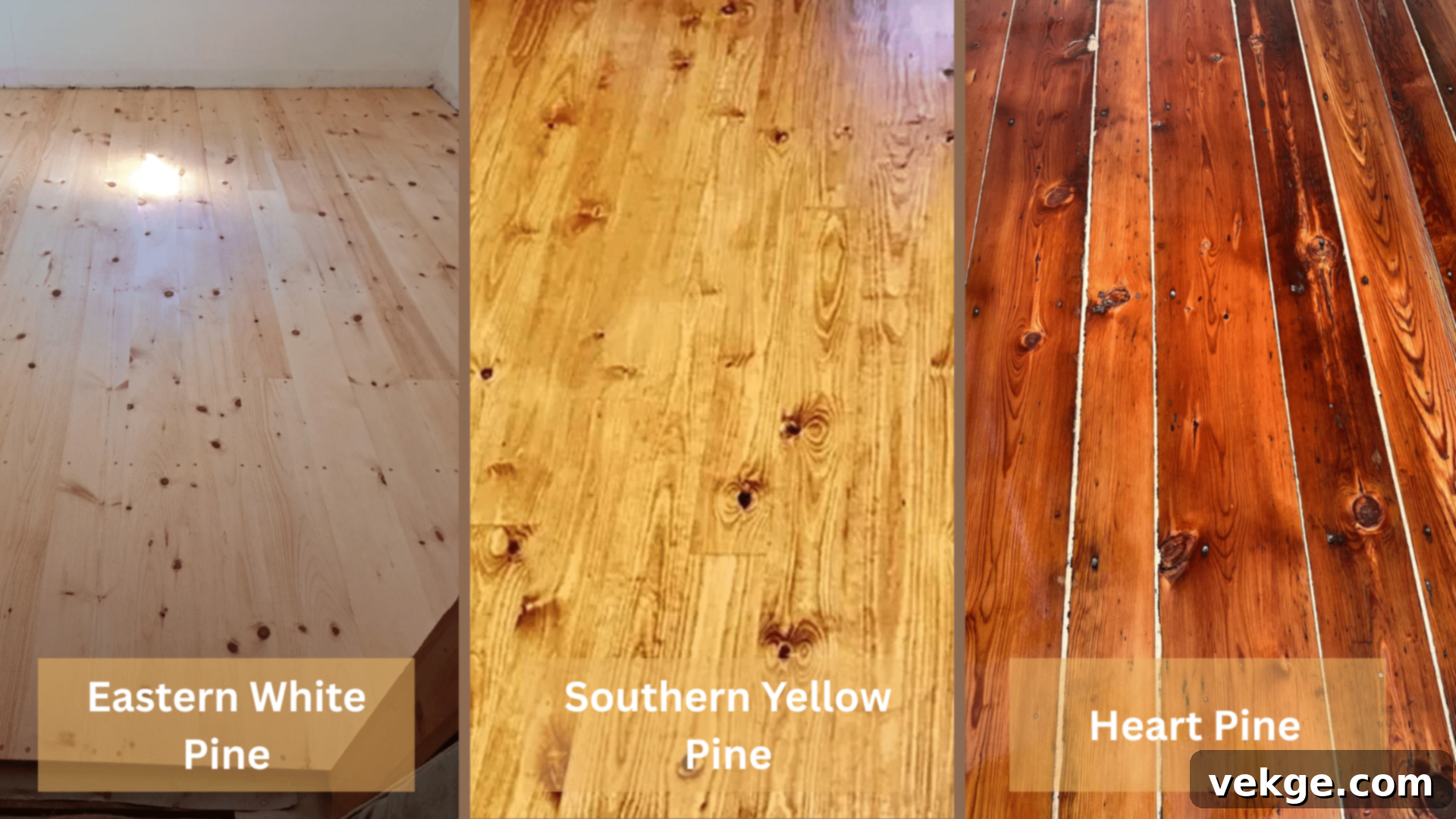
Before selecting a finish, it’s essential to understand the type of pine you’re working with. Each variety boasts unique qualities that influence its suitability for different areas and how various finishes will interact with its grain and density. Knowing your pine is the first step toward a successful and long-lasting finish.
Here’s a detailed look at the primary types of pine commonly used in flooring:
1. Eastern White Pine
Eastern White Pine is a classic choice known for its softness and light, pale, almost creamy color, often featuring distinct, dark knots. Its smooth texture and open grain make it easy to work with, offering a rustic and traditional charm to any space. This softwood is best suited for areas with moderate to low foot traffic, such as bedrooms, studies, or formal living rooms, where its natural beauty can be appreciated without constant heavy wear.
Its more natural and less uniform appearance allows the wood grain and knots to truly stand out, imparting a warm, inviting, and authentic farmhouse aesthetic. However, due to its inherent softness, Eastern White Pine is more susceptible to dents, scratches, and dings compared to denser pine varieties. Many homeowners embrace these imperfections as part of its character, allowing the floor to develop a unique patina over time.
2. Southern Yellow Pine
In stark contrast to its softer cousin, Southern Yellow Pine is celebrated for its remarkable strength, density, and durability, making it an excellent choice for high-traffic areas. It typically showcases a deep, golden-yellow to orange-brown hue, often with dramatic grain patterns that include both earlywood and latewood. This density makes it significantly more resistant to common damage like scratches, dents, and moisture absorption, offering robust performance in busy environments.
Southern Yellow Pine is frequently utilized in both residential and commercial settings where resilience is a top priority, including kitchens, hallways, and entryways. Its robust nature means it can withstand heavy use while still providing an attractive and warm finish that complements various interior designs. Its inherent strength also makes it a popular choice for structural applications, reinforcing its reputation as a hard-wearing timber.
3. Heart Pine
Heart Pine is the densest and most durable of all pine varieties used for flooring, derived from the central, mature core (heartwood) of longleaf, shortleaf, or loblolly pine trees, often from old-growth timber. Its color spectrum ranges from rich reddish-browns to deep amber tones, imbuing any room with a sense of historic elegance and sophistication. Given its exceptional hardness and resistance to wear, Heart Pine is perfectly suited for even the most high-traffic areas.
Often salvaged from old buildings, reclaimed Heart Pine is highly sought after for its unique character, tight grain patterns, and striking patina, making it a premium choice for historic homes or for those aiming to replicate a traditional, timeless look. Beyond its impressive durability, Heart Pine offers a distinctive, vintage feel that adds considerable character, warmth, and enduring value to any space, standing as a testament to natural strength and beauty.
Comparing Pine Floor Finishes: Hardwax Oil, Varnish & More

The choice of finish is paramount, as it dictates the look, feel, and protective qualities of your pine floor. Below, we compare several popular options, detailing their pros, cons, ideal applications, and examples of products to help you discern their differences and select the best fit for your needs.
| Flooring Type | Pros | Cons | Best for | Examples of Products |
|---|---|---|---|---|
| Pine (Hardwax Oil) | Natural look and feel, easy spot repair, enhances wood grain, breathable, low VOC options. | Less abrasion resistance than varnish, requires reapplication every few years, not ideal for very wet areas. | Low to medium traffic areas (bedrooms, living rooms), natural aesthetic preference, DIY-friendly repairs. | Osmo Polyx-Oil, Fiddes Hard Wax Oil |
| Pine (Varnish / Polyurethane) | High durability, excellent scratch and stain resistance, waterproof barrier, long-lasting protection, various sheen levels. | Harder to repair (requires full re-sanding for major issues), can appear “plastic-y” if applied too thick, oil-based can yellow over time. | High-traffic areas (kitchens, hallways), moisture-prone spaces, commercial settings, maximum protection. | Water-based polyurethane (e.g., Varathane), Oil-based polyurethane |
| Pine (Tung Oil) | Deeply penetrates wood, natural, water-resistant, enhances natural color and grain depth, repairable. | Very long drying and curing time; requires multiple coats for adequate protection, moderate durability (less than varnish). | Homes seeking a truly natural, hand-rubbed finish; areas with light traffic; antique reproduction. | Pure Tung Oil, Hope’s Tung Oil |
| Pine (Wax Finish) | Soft matte sheen, easy to apply and repair for minor scuffs, natural tactile feel. | Least durable, wears off quickly, not water-resistant, attracts dirt, can be slippery, difficult to apply other finishes over. | Very low-traffic areas (closets, decorative spaces), where aesthetic is prioritized over protection, antique furniture. | Briwax, Minwax Paste Finishing Wax |
| Pine (Laminate Coating) | Extreme scratch and abrasion resistance, highly durable, exceptional for heavy traffic, chemical resistant. | Difficult to repair if damaged (often requires professional re-application), can look less natural than traditional finishes, higher cost. | Commercial spaces, industrial settings, extremely high-traffic residential areas where maximum protection is non-negotiable. | Specialized two-part epoxy or very high-grade clear urethane systems. (Note: This refers to a durable clear coating, not laminate plank flooring.) |
Beyond the table, let’s explore these finishes in more detail:
Hardwax Oil: The Natural Choice
Hardwax oils are a blend of natural oils (like linseed, sunflower, or soybean) and waxes (carnauba or candelilla). Unlike varnishes that form a film on the surface, hardwax oils penetrate deep into the wood fibers, enhancing the natural beauty and texture of the pine. They leave a breathable, open-pored finish that allows the wood to “breathe,” feeling more natural and warm underfoot. This makes them perfect for those who desire a tactile connection with their wood floors. Hardwax oils are also easy to maintain; minor scuffs and scratches can often be spot-repaired without needing to refinish the entire floor, which is a significant advantage in busy homes. However, they offer less resistance to harsh chemicals and heavy abrasion compared to varnishes and typically require reapplication every 1-5 years depending on traffic.
Varnish (Polyurethane): The Durable Protector
Varnish, particularly polyurethane-based finishes, creates a robust, protective layer on top of the pine wood. This film acts as a shield against scratches, stains, and moisture, making it an excellent choice for high-traffic areas like kitchens, entryways, and family rooms. Polyurethane finishes are available in water-based and oil-based formulations. Water-based polyurethanes dry faster, have lower VOCs, and typically remain clear, making them ideal for preserving the natural pale tone of pine. Oil-based polyurethanes, while more durable, tend to amber or yellow over time, adding a warm, golden hue that some prefer. While incredibly durable, repairing a varnished floor can be more challenging, often requiring sanding and refinishing of an entire section or even the whole room to achieve a seamless look if damage is significant.
Tung Oil: The Deep Penetrator
Pure Tung Oil, derived from the nuts of the tung tree, is a natural, non-toxic finish that deeply penetrates the wood, hardening within the fibers to provide water resistance and a subtle, hand-rubbed look. It brings out the rich depth of the wood grain without forming a thick surface film, resulting in a very natural, almost wet appearance. Tung oil is particularly popular among those seeking an eco-friendly and food-safe finish. However, achieving adequate protection requires multiple coats, and each coat can take a long time to dry and cure, making the application process lengthy. Its durability is moderate, less than varnish but often more reparable than film-forming finishes.
Wax Finish: The Soft Sheen
Wax finishes, such as paste wax, offer the softest, most natural sheen for pine floors, typically a delicate matte or satin. They are relatively easy to apply and can provide a beautiful, traditional aesthetic, enhancing the wood’s inherent warmth. Wax penetrates the surface slightly and then hardens, offering some protection against light wear. However, wax is the least durable option among these finishes. It is not water-resistant, can attract dirt, and requires frequent reapplication. It’s best reserved for very low-traffic areas or decorative spaces where spills and heavy use are not a concern. Applying other finishes over wax can also be problematic without extensive removal.
Choosing the Best Finish for Your Pine Floor
Selecting the ideal finish for your pine floor is a decision that should be guided by a balance of practical considerations and personal preferences. Factors such as your home’s traffic levels, your desired aesthetic, your commitment to maintenance, and even your budget will play a significant role. Let’s break down how to make the most informed choice.
Deciding Between Hardwax Oil and Varnish: A Deeper Dive
When weighing hardwax oil against varnish, consider your priorities carefully. If you crave a highly natural, breathable look and feel, where you can literally feel the wood grain, and value the ease of spot repair for minor scuffs and scratches, then hardwax oil is likely your preferred option. It fosters a more intimate connection with the wood and is excellent for spaces where a rustic or organic aesthetic is paramount, despite requiring more frequent reapplication.
Conversely, if your primary concern is maximum protection against spills, heavy foot traffic, and abrasive wear from pets or children, then varnish, particularly a high-quality polyurethane, will serve you better. It creates a robust, impermeable barrier that is incredibly durable and generally requires less frequent full refinishing. While harder to repair seamlessly in small areas, its long-term protective qualities are unmatched, making it ideal for the busiest parts of your home where functionality and longevity are key.
Key Factors to Consider for Your Pine Floor Finish
Making the right choice involves evaluating several practical aspects:
- Traffic Level: This is arguably the most critical factor. For high-traffic areas like entryways, hallways, and kitchens, a highly durable finish like varnish (polyurethane) is usually superior. In contrast, low to moderate traffic zones such as bedrooms, dining rooms, or home offices can benefit from the natural appeal and reparability of hardwax oil or even tung oil.
- Desired Aesthetic: Do you prefer a matte, natural look that highlights the wood’s texture and allows it to develop a rich patina over time? Hardwax oils and tung oils excel here. Or do you prefer a more uniform, sealed appearance with a range of sheens from satin to high-gloss? Varnish offers this versatility. Consider how the finish will complement your home’s overall design.
- Maintenance Commitment: How much time and effort are you willing to invest in your floor’s upkeep? Hardwax oils require more frequent, but generally simpler, reapplication (often just a clean and re-oil every 1-5 years). Varnishes, while requiring less frequent major work, can be more labor-intensive to fully refinish when the time comes, often involving complete sanding. Daily cleaning is essential for all finishes, but specific cleaning agents may vary.
- Budget: The initial cost of materials can vary, with some premium hardwax oils being more expensive per liter than standard polyurethanes. However, also consider the long-term cost of reapplication or professional refinishing over the lifespan of your floor. Generally, varnish might have a lower initial material cost for standard options, while hardwax oils can be a greater upfront investment but offer DIY repair savings.
- Environmental Concerns and VOCs: If minimizing exposure to volatile organic compounds (VOCs) is a priority, look for water-based polyurethanes or natural hardwax oils with low-VOC formulations. Pure tung oil is also a very natural, non-toxic option.
- DIY vs. Professional Application: Some finishes are more forgiving for DIY application than others. Hardwax oils are often considered easier for homeowners to apply and repair. Varnish requires more meticulous application techniques to avoid streaks and bubbles for a professional-looking result.
Considerations for Staining Pine Floors Before Finishing
Staining your pine floor before applying a protective finish is an excellent way to dramatically change its color, deepen its tone, or even out its appearance. Pine can be prone to blotchiness when stained due to its varied density, so using a pre-stain wood conditioner is highly recommended to ensure a more even color absorption. If you desire a darker, richer hue, or wish to mimic the look of more expensive hardwoods, staining is a great option.
However, it is paramount to ensure that the stain you choose is compatible with your intended finish. Oil-based stains typically work well with oil-based varnishes and many hardwax oils, but can sometimes be problematic with water-based finishes if not fully cured. Water-based stains pair best with water-based topcoats. Some finishes, like certain hardwax oils, are designed to be applied directly to bare wood or specific types of stains, while others may cause discoloration or adhesion issues if applied over incompatible stain types or if the stain hasn’t thoroughly dried. Always allow ample drying time for your stain, and critically, test your chosen stain and finish combination on a small, inconspicuous area or a scrap piece of pine first to observe how they react together and confirm the final color.
How to Apply Pine Floor Finishes: A Step-by-Step Guide
Applying a finish to your pine floors, whether it’s hardwax oil or varnish, is a rewarding DIY project that requires careful preparation and precise execution. Following the correct steps will ensure a beautiful, long-lasting, and protective result that enhances your home’s appeal.
1. Preparing Your Floor for Finishing: The Foundation of Success
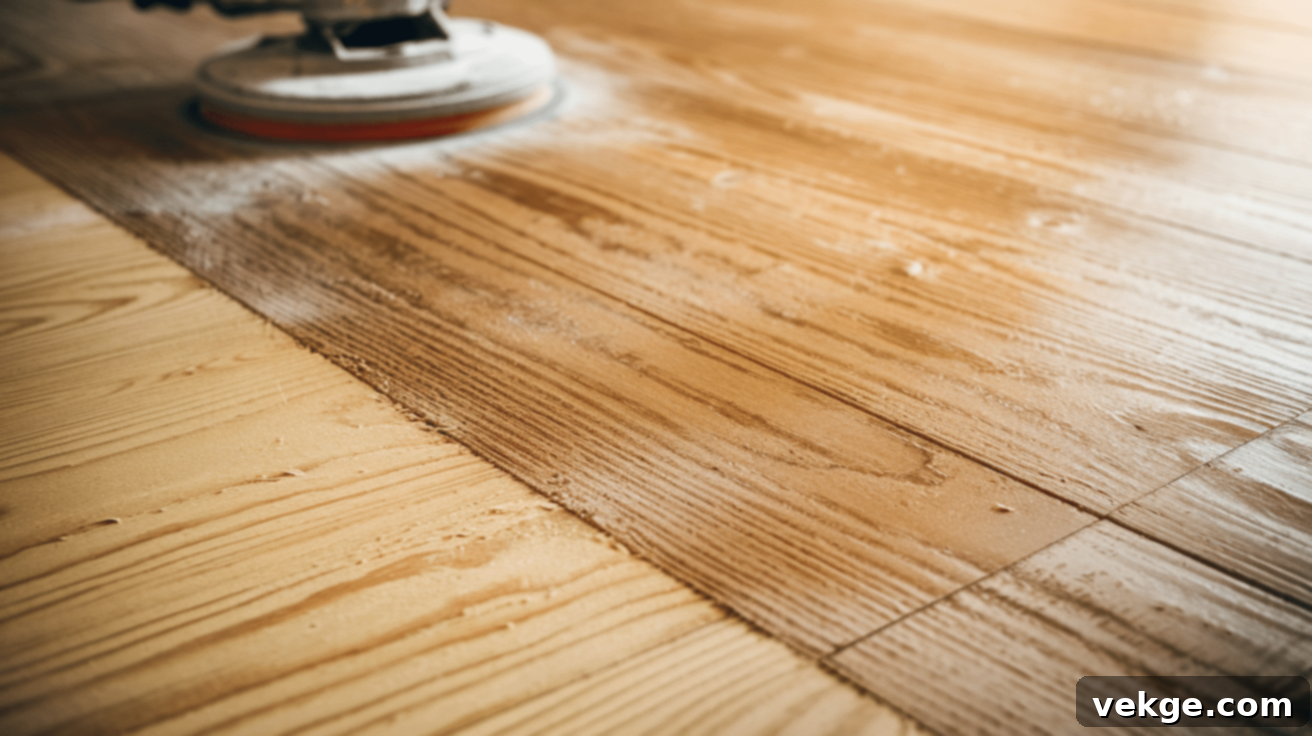
Proper preparation is the most critical step for any successful floor finishing project. Begin by thoroughly sanding your floor to remove any old finishes, deep scratches, dents, or rough spots. Start with a coarser grit sandpaper (e.g., 60 or 80-grit) to remove old finishes and flatten the surface, then progress through finer grits (e.g., 100 or 120-grit) to achieve a smooth, uniform surface ready for finishing. Ensure you sand with the grain of the wood to prevent unsightly swirl marks.
Once sanding is complete, meticulously clean the floor to eliminate all dust, dirt, and sanding residue. Use a powerful vacuum cleaner, followed by a tack cloth, or a micro-fiber cloth lightly dampened with mineral spirits (if compatible with your chosen finish) to pick up any fine particles. Any leftover debris can severely compromise the adhesion and appearance of your finish. If you plan to stain your pine floors to achieve a different color or tone, now is the time to apply it, following the manufacturer’s instructions for even coverage and proper drying. Remember to use a pre-stain conditioner for pine to help prevent blotchiness.
2. Application Process for Hardwax Oil: Enhancing Natural Beauty
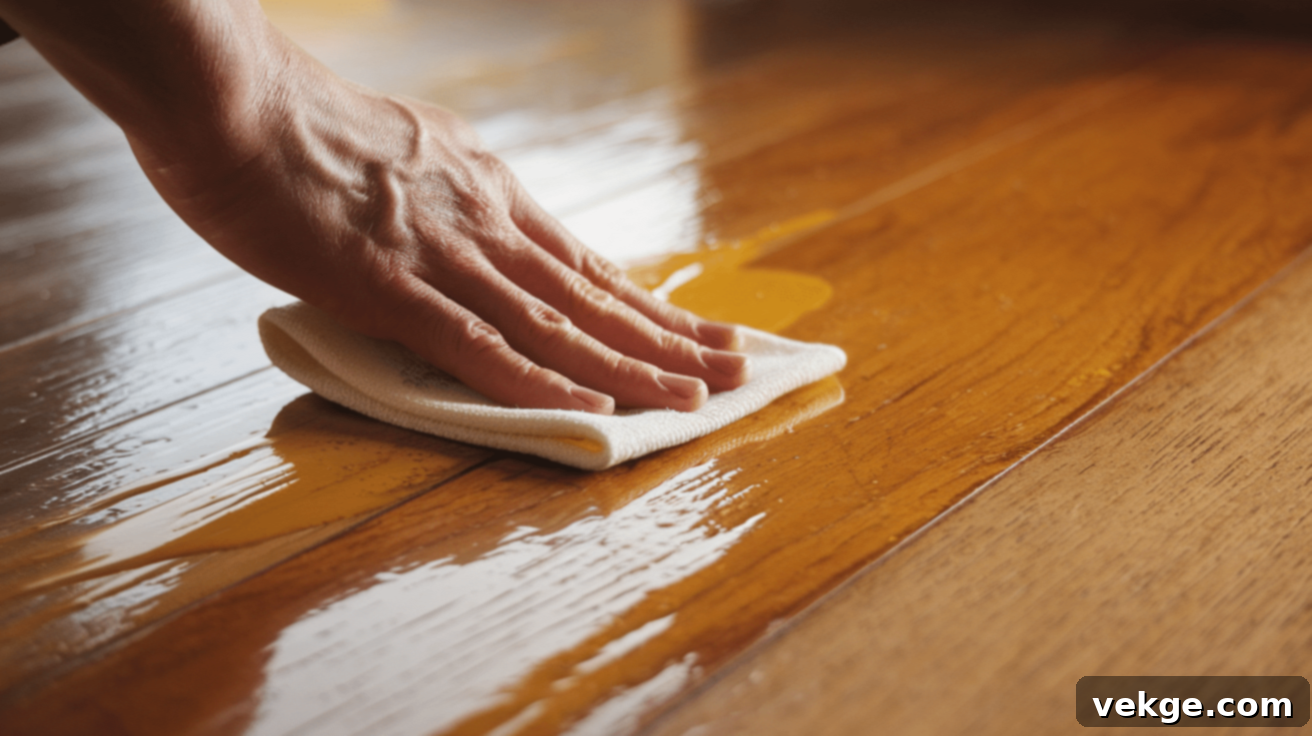
Applying hardwax oil is generally a straightforward process that emphasizes thin, even coats. Use a clean, lint-free cloth, a specialized hardwax oil applicator pad, or a high-quality brush to spread the oil. Work in small, manageable sections, moving with the direction of the wood grain. The key is to apply a very thin, almost “dry” coat, avoiding any pooling, as excess oil can lead to sticky patches or an uneven finish.
Allow the first coat of oil to penetrate the wood for approximately 20-30 minutes (always check manufacturer guidelines). Then, thoroughly wipe off any excess oil with a clean, absorbent cloth, ensuring the surface feels dry to the touch, not oily. Let the floor dry for 24-48 hours before applying a second, equally thin coat. Most hardwax oil systems recommend two coats for optimal protection. While light foot traffic may be possible after 24-48 hours, allow the floor to fully cure for several days (up to a week) before placing heavy furniture or rugs. Remember, hardwax oil typically needs to be reapplied every 1-5 years, depending on the level of foot traffic and wear.
Personal Recommendation: Osmo Polyx-Oil (Original)
- Why? Osmo Polyx-Oil is widely considered a gold standard in hardwax oils. It is formulated from natural oils and waxes, deeply penetrating the wood to improve its natural beauty while providing exceptional durability and water resistance from within. It maintains the wood’s breathability and allows for easy spot repairs, making it incredibly homeowner-friendly. Its low VOC content is another significant benefit.
- Finish options: Available in Matte, Satin, and Gloss, offering versatility for different aesthetic preferences.
- Coverage: Very economical, typically covering approximately 260 ft² per liter per coat.
- Price: Around $55–$65 per liter, a worthwhile investment for its quality and longevity.
3. Application Process for Varnish (Polyurethane): Building a Protective Shield
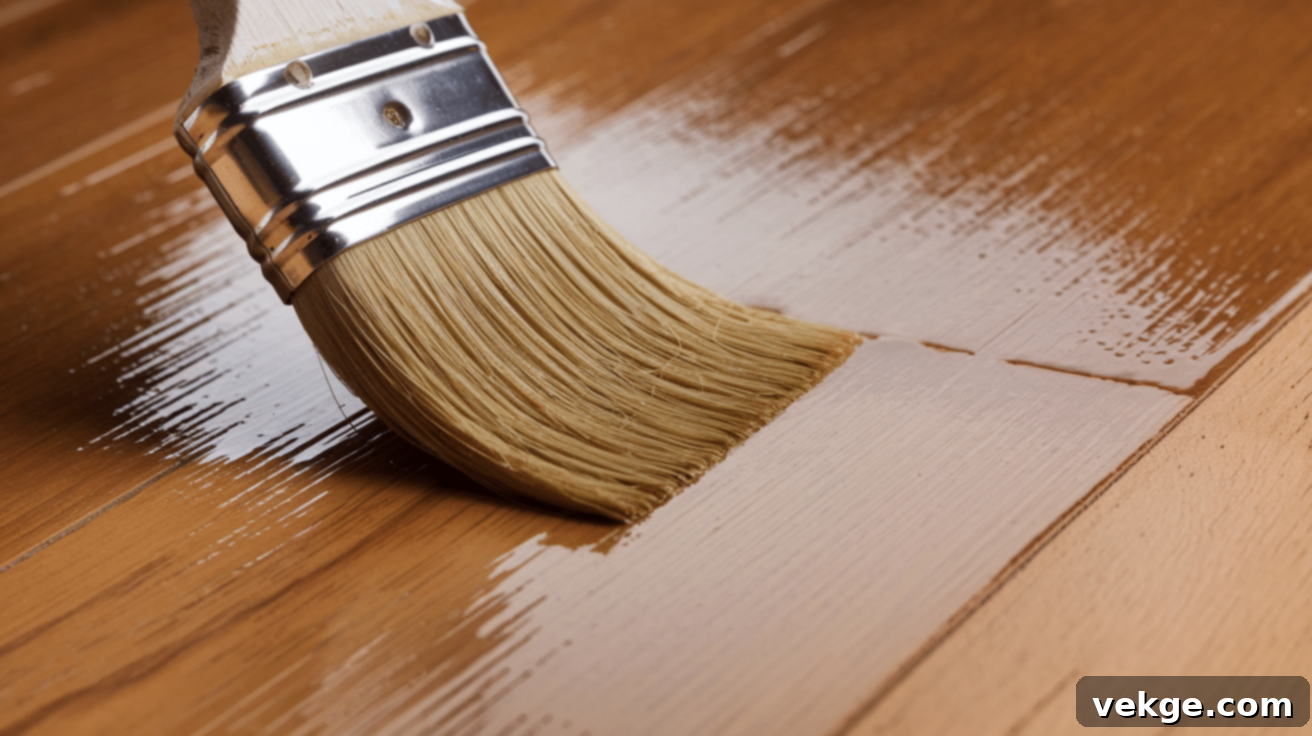
When applying varnish, particularly polyurethane, use a high-quality synthetic brush for edges and corners, and a micro-fiber roller or lamb’s wool applicator for the main floor. Apply a thin, even coat, always working in the direction of the wood grain to prevent streaks and brush marks. Avoid overworking the varnish or applying it too thickly, as this can lead to bubbles, drips, and extended drying times.
Allow the first coat to dry thoroughly, typically 4-6 hours for water-based and 12-24 hours for oil-based polyurethanes (always consult the product’s instructions). Once dry, lightly sand the entire floor with a fine-grit sandpaper (e.g., 220-grit) using a pole sander to smooth out any imperfections and ensure proper adhesion for subsequent coats. After sanding, meticulously clean all dust from the floor with a vacuum and tack cloth. Apply 2-3 additional coats, following the same drying and light sanding process between each, for optimal durability and a smooth finish. Varnish can take 24 to 48 hours for light foot traffic and up to 1-2 weeks to fully cure and achieve its maximum hardness, so patience is key before resuming normal use or placing rugs.
Personal Recommendation: Varathane Water-Based Floor Finish (by Rust-Oleum)
- Type: Water-based polyurethane, known for its quick drying time and low odor.
- Finish options: Widely available in Satin, Semi-Gloss, and Gloss to suit various preferences.
- Why it’s great: Varathane offers excellent durability and is extremely affordable and readily available at major home improvement stores like Home Depot or Lowe’s, making it a convenient and cost-effective option for DIYers. It’s clear-drying, which helps preserve the natural color of pine.
- Coverage: Provides good coverage, typically 400–500 ft² per gallon per coat.
- Price: Very budget-friendly, often around $40–$50 per gallon.
Maintenance and Repairing Pine Floors: Protecting Your Investment
Proper and consistent maintenance is absolutely essential to ensure your pine floors retain their beauty and longevity, regardless of the finish you choose. Regular care not only keeps the wood looking pristine but also acts as a preventative measure against premature wear and damage. The more diligent you are with routine maintenance, the less frequently you’ll need to undertake more intensive repairs or complete refinishing projects.
Key Tips for Maintaining and Preserving Pine Floors:
- Regular Cleaning: Sweep or vacuum your floors frequently (daily or every other day, especially in high-traffic areas) to remove abrasive dirt, grit, and debris that can act like sandpaper underfoot and dull the finish.
- Immediate Spill Cleanup: Clean up any spills immediately. Water, food, or chemical spills can stain, swell, or damage the wood and its finish if left to sit. Use a clean, damp cloth and blot, rather than rub, the affected area.
- Furniture Protection: Always use felt pads or furniture glides under the legs of all furniture (chairs, tables, sofas, cabinets) to prevent scratches, dents, and gouges when items are moved.
- Entryway Mats: Place doormats at all exterior entrances to trap dirt, moisture, and debris before it can be tracked onto your pine floors.
- Area Rugs: Use area rugs in high-traffic zones or under dining tables to provide extra protection against wear and tear. Ensure rugs have breathable backings to prevent moisture trapping.
- Proper Cleaners: Use cleaning products specifically designed for finished wood floors. Avoid harsh chemicals, ammonia-based cleaners, abrasive pads, or steam mops, as these can strip or damage your finish. For hardwax oil, use pH-neutral or specific soap-oil cleaners; for varnish, a gentle wood floor cleaner is usually sufficient.
- Pet Care: Keep pet nails trimmed to minimize scratches, especially on softer pine varieties or with hardwax oil finishes.
- Humidity Control: Maintain consistent indoor humidity levels (ideally between 35-55%) to prevent the wood from expanding, contracting, gapping, or cupping.
Repairing Common Damage on Pine Floors:
- For Hardwax Oil Finishes: Minor scratches, scuffs, or worn spots are remarkably easy to repair. Lightly clean the affected area, then gently sand it with a fine-grit sandpaper (e.g., 220-320 grit) to remove the superficial damage. Apply a small amount of the original hardwax oil to the sanded spot, allow it to penetrate, and then wipe off the excess. Hardwax oil blends seamlessly, making spot repairs virtually invisible. For deeper scratches or dents, you may need to apply wood filler before sanding and re-oiling.
- For Varnish Finishes: Minor surface scratches on varnished floors can sometimes be minimized with touch-up pens or specialized repair kits designed for polyurethane. For deeper scratches, or areas where the finish has been compromised, repair is more complex. You might need to lightly sand the damaged area and carefully apply thin coats of varnish, trying to feather the edges to blend with the existing finish. However, achieving an invisible repair on a film-forming finish like varnish is challenging; often, a full recoat of the entire room is necessary for larger areas of wear or damage to ensure a uniform appearance. For very deep gouges or dents, wood filler can be used, but it will need to be sanded smooth and then refinished with varnish.
Wrapping Up: Your Ideal Pine Floor Awaits
By now, you should have a much clearer understanding of the significant differences between various finishes for your pine floors and how each option impacts their appearance, durability, and required maintenance. Whether you’re aiming for a beautifully natural appearance, robust protection for a bustling household, or a balance of both, there’s a pine floor finish perfectly suited to your specific needs and lifestyle.
Remember, hardwax oil is the premier choice for those seeking a highly natural, breathable feel with easy spot repair capabilities, ideal for moderate traffic and a rustic aesthetic. In contrast, varnish (polyurethane) provides unparalleled protection against heavy foot traffic, moisture, and abrasions, making it the go-to for the busiest areas of your home where maximum durability is paramount.
Ultimately, the finish you choose for your pine floors should reflect your personal preferences, your daily routine, and the level of care you’re willing to dedicate. With the insights gained from this guide, you are now equipped to make an informed decision that will protect and beautify your pine floors for many years to come.
Why wait? Take the next step in your home improvement journey. Choose the finish that best aligns with your vision and lifestyle, and begin the rewarding project of transforming your pine floors. Experience the enduring beauty and character it brings to your space!
